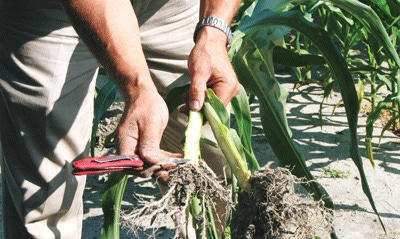September 10, 2010

After the hot summer, many farmers are facing crops that may have under-performed due to the weather. But bare spots, excessively weedy areas or crops that look stunted, discolored or wilted may also signal a problem with plant-parasitic nematodes.
Nematodes are microscopic worms, most of which live in soil. Now is a good time to scout fields for problems, collect samples and do some troubleshooting. It won’t help the current crop, but you’ll be able to plan better for the next one.
“Nematodes tend to be hidden pests,” said Weimin Ye, nematologist with the North Carolina Department of Agriculture and Consumer Services. “They damage roots and interfere with the uptake of water and nutrients. The injury is not obvious right away. However, in late summer, populations peak and symptoms are more apparent.”
Identifying nematode problems is difficult because, in most cases, there is no single, easily recognizable symptom. General problems such as wilting, discoloration, stunting, patchy growth or weed prevalence can all indicate a nematode infestation, but none of these symptoms are definitive. The surest way to diagnose a nematode problem is to collect soil and root samples and send them to the NCDA&CS nematode assay lab, said Ye.
Although nematodes can occur in all soils, crops growing in sandy soils are particularly vulnerable to damage. For this reason, growers in eastern counties are advised to test their fields annually. For a minimal fee ($3 for North Carolina samples and $10 for out-of-state samples), a Nematode Assay Report by the NCDA&CS Agronomic Division can provide valuable information about your soil such as the species of plant-parasitic nematodes present, their relative abundance, the degree of hazard they pose to the specified crop and best management practices, if necessary.
Basic information
“This is the basic information needed to manage nematode populations adequately,” Ye said. “With these details, growers can make informed decisions about which crops to plant and whether or not to use chemical treatments.”
Growers are advised not to grow the same crop in the same field year after year. Many nematode populations can be kept at manageable levels by choosing good rotation crops.
It is also not advisable to use the same nematicide on the same field year after year, said Ye. Routine application is expensive, may be unnecessary and can lead to the build-up of nematicide resistance.
Instructions for collecting and submitting samples for nematode assay are available online at www.ncagr.gov/agronomi/pdffiles/samnemas.pdf. Samples can be taken now or immediately after crop harvest in the fall — when nematode populations are likely to be at their highest. However, the process for collecting samples now, while a crop is in the field, is different from that recommended after harvest when damage cannot be seen.
Samples collected from an existing crop are problem, or diagnostic, samples and should be collected from the edge of the affected area. For comparison, each problem sample should be submitted along with a sample from a “good,” or relatively healthy looking, area in the same field. On the other hand, samples collected after harvest are routine, or predictive, samples and should randomly represent the entire field.
For further advice on how to collect samples or manage nematode populations, contact your NCDA&CS regional agronomist by visiting www.ncagr.gov/agronomi/rahome.htm or calling (919) 733-2655. Schedule a site visit if you need help troubleshooting nutrient or nematode-related crop growth problems.
You May Also Like




